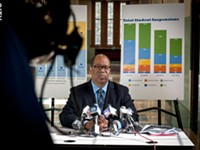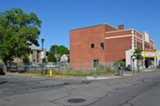[
{
"name": "500x250 Ad",
"insertPoint": "5",
"component": "15667920",
"parentWrapperClass": "",
"requiredCountToDisplay": "1"
}
]
The latest evolution in teacher evaluations ironed out between the Rochester Teachers Association and the city school district is extremely complex. And it's hard to tell if it will provide much clarity about teacher performance.
"It makes a bad system less bad," says RTA President Adam Urbanski.
But failure to reach agreement to implement the state's Annual Professional Performance Review law would have put $40 million in funding and more than 400 teacher positions at risk in the 2012-2013 school year, he says.
In a July 6 letter to RTA members, Urbanski says that the APPR "is neither our idea nor a good law."
The toughest negotiations between the RTA and the Rochester school district were over the impact of student absenteeism on teacher evaluations.
New York State United Teachers, the state's largest union, has argued for months that in a fair evaluation system, teachers can't be held accountable for students who haven't been in school at least 80 percent of the year. It shouldn't surprise anyone, they say, that those students aren't likely to pass state tests.
The latest plan, which still has to be approved by the State Education Department, addresses some of the union's concerns. The APPR is basically divided into three main components, with 20 percent of the evaluation based on how students perform on standardized state tests. The state has not indicated that adjustments will be made to this portion of the APPR, Urbanski says, regardless of a student's attendance record.
But another 20 percent of the evaluation is based on tests used at the local level. The RTA and the district have agreed on a set of formulas that will adjust the teacher's evaluation in proportion to the student's attendance and other issues.
The formulas do not alter students' test scores. But they do factor in student attendance, poverty level, English language skills, and special education classification when measuring teacher performance against test scores.
The local tests will also be what educators call "authentic and performance-based." Unlike multiple choice tests, which are designed to test the student's ability to find correct answers to questions, authentic assessment examines whether the student understands how to use the information.
For example, instead of asking a kindergarten student to mark the picture of a shoe tied correctly, the student might be asked to tie a shoe, Urbanski says. The latter, according to some educators, provides a deeper understanding of the student's skills.
The remaining 60 percent of the APPR is based on observations of teacher performance. And teachers have a say in how this portion will be conducted. They can choose to have their supervisor, typically the school principal or vice principal, evaluate and score them. A second option is to split the evaluation between a supervisor and a master teacher. This would allow a teacher to be observed by another teacher who is highly skilled in the same subject area.
The third option is to split the evaluation with a supervisor, and for the remaining portion, a teacher can work as part of a team of teachers on a special project. The entire team, not the individual teacher, would be evaluated on the success of the project.
Teachers would also be required to work with teachers and parents in their schools to come up with a plan to reduce student absenteeism.
The average absenteeism rate for the district last year was about 10 percent, Urbanski says. "But some schools have much higher absentee rates and other schools have lower rates," he says.
Latest in News
More by Tim Louis Macaluso
-

RCSD financial crisis builds
Sep 23, 2019 -

RCSD facing spending concerns
Sep 20, 2019 -

Education forum tomorrow night for downtown residents
Sep 17, 2019 - More »






